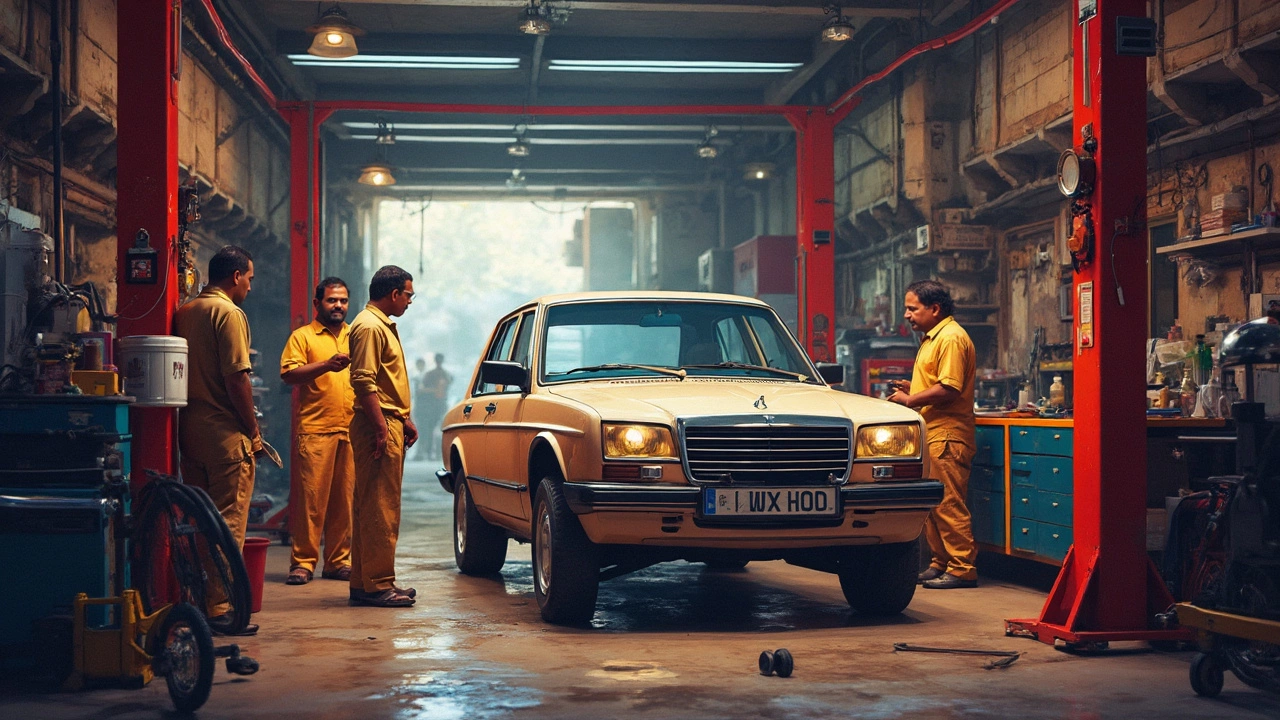 Mar, 19 2025
Mar, 19 2025
So, you're knee-deep into car maintenance, and the dreaded clutch replacement is on your to-do list. But amidst this, a burning question might linger in your mind: Do I need a new flywheel when I replace my clutch? It's a valid question that doesn't come with a straightforward answer.
First off, let's talk about what a flywheel does. It's not just a random piece of metal. This crucial component helps in balancing the engine and storing energy, ultimately making sure your ride is smooth. Over time, just like any other part, it can wear out. If it's gone bad, ignoring it might cause more headaches down the road.
Signs of a worn-out flywheel aren't always obvious, but if you're experiencing unusual noises or the clutch seems to engage roughly, your flywheel might need a closer look. A damaged flywheel can lead to poor engine performance—a major bummer if you're aiming for a smooth driving experience.
- Understanding the Role of the Flywheel
- Signs Your Flywheel Needs Replacement
- How a Damaged Flywheel Affects Performance
- Cost Considerations and Budgeting
- DIY vs Professional Replacement
- Concluding Thoughts on Flywheel Replacement
Understanding the Role of the Flywheel
The flywheel is a crucial component that often doesn't get the spotlight it deserves. Sitting between your engine and transmission, its primary job is to store rotational energy. This allows your car to run smoothly even when the pistons aren't firing.
A well-functioning flywheel ensures a smooth clutch engagement, which is why it's so important during a clutch replacement. Actually, it's what helps to reduce wear and tear on your clutch components, making it longer-lasting. Want to know a fun fact? Leonardo da Vinci is credited with some of the earliest sketches of a flywheel, showing how long this concept has been in play!
"Flywheels are like the unsung heroes of car mechanics—they work tirelessly to keep things running smoothly." —Automotive Expert, John Harris
In essence, the flywheel acts like a stabilizer. When you're shifting gears or your car is idling, it helps absorb the vibrations from the engine. Without it, you'd feel every jolt and hiccup, and that's far from ideal.
Role in Balancing and Energy Storage
Another role the flywheel plays is in balancing the engine's performance. Engines create power in pulses, so the flywheel smooths this out, ensuring your drive is steady. It's like having someone manage a water flow rate, keeping it consistent instead of surging.
So why think about this now? When you’re considering replacing a flywheel along with a clutch, remember its role in reducing load on the engine. It may cost more upfront, but it can save some serious cash on repairs later.
Signs Your Flywheel Needs Replacement
Not sure if your car needs a new flywheel? Pay attention to these tell-tale signs. Ignoring them could vibe with headaches you don't need when it comes to car maintenance.
Unusual Noises
If you hear grinding or banging when driving, your flywheel might be trying to tell you something. These noises are usually a sign of wear and can lead to bigger issues if left unchecked. Noise is often one of the first noticeable signs that something's amiss.
Slipping Gears
Ever tried to shift gears and felt the clutch slip? It's frustrating. A clutch replacement might not be enough if your flywheel is on its way out. The worn-out surface of the flywheel can lead to slipping, and a smooth drive becomes a distant memory.
Burning Smell
Catch a whiff of burning smell around your transmission? This could mean the flywheel is generating excessive heat from friction, which isn't what you want. This demands immediate attention to prevent costly repairs.
Vibrations
Feel those shakes when you press the clutch pedal? It might not be road bumps but a sign of a faulty flywheel. Vibrations from the flywheel can affect the overall stability and performance of your vehicle.
| Symptom | Possible Cause |
|---|---|
| Unusual noises | Worn flywheel |
| Slipping gears | Smooth flywheel surface |
| Burning smell | Excessive friction |
| Vibrations | Faulty flywheel |
Remember, regularly checking these signs can save you a trip to the mechanic, or at least prepare you better for that inevitable visit. Keeping an eye on these symptoms can help ensure your car runs smoothly and safely.
How a Damaged Flywheel Affects Performance
When a flywheel is on the fritz, it's not just your smooth driving telling you something's up. A flywheel that’s seen better days can mess with your whole driving experience.
What Happens Under the Hood?
The flywheel plays a vital role in balancing the engine. If it's damaged, it can lead to excessive vibrations. You might start feeling these shakes seep through the steering wheel or even in the driver's seat. Not exactly the relaxing drive you had in mind, right?
Clutch Engagement Woes
Imagine trying to accelerate smoothly, and instead, your car jerks like a bucking bronco. That's sometimes what happens when the flywheel isn’t doing its job well. This rough engagement can make your ride feel less pleasant and more like a rollercoaster, minus the fun.
Impact on the Engine
A bad flywheel can lead to misfires or even damage to other engine parts. This not only affects engine performance but might also mean more dollars on repairs in the future—a scenario everyone wants to avoid.
Remember, while it might be tempting to cross your fingers and hope the flywheel holds out after a clutch replacement, checking its condition beforehand can save you from future frustrations. Plus, who doesn't like avoiding extra repair costs?
| Component | Effect of Damage |
|---|---|
| Flywheel | Excessive vibration, rough clutch engagement |
| Engine | Possible misfire, additional damage risks |

Cost Considerations and Budgeting
When it comes to clutch replacement, keeping an eye on your budget is crucial. The whole process can be costly, and whether you need a new flywheel plays a big part in that.
What You Can Expect to Spend
Generally, replacing just the clutch might cost anywhere between $500 to $2,500, depending on the type of vehicle and the garage labor rates in your area. Adding a new flywheel to the mix can bump that cost up by another $200 to $500.
Factors Affecting Cost
- Vehicle Type: Luxury cars usually come with a heavier price tag for parts and labor.
- Labor Rates: Rates can vary widely, with some city areas charging up to $150 per hour.
- Condition of Parts: If other related parts like the pressure plate or release bearing also need replacement, prepare to spend more.
With these variables, it helps to get a few quotes before making a decision. Additionally, OEM parts might cost more but provide better quality long-term.
Saving Tips
Thinking of saving a few bucks? Here are some practical tips:
- Research multiple shops for competitive rates.
- Consider purchasing the clutch kit and flywheel online if you've found a good deal.
- Ask about warranties; some clutches offer guarantees which might save you future costs.
Being proactive in understanding these expenses ensures you don't get caught off guard. Even though it's a significant outlay, doing it right the first time could save money long-term.
DIY vs Professional Replacement
When it comes to replacing the clutch and potentially the flywheel, the decision between doing it yourself and hiring a pro is crucial. If you've got some car repair chops, this could be a chance to save some serious cash. However, there’s a lot at stake, so let's break down what you need to know.
DIY Replacement
Going the DIY route can be appealing, especially if you're familiar with your vehicle's intricate workings. Here's what you need:
- Tools & Equipment: Ensure you have specialized tools like a clutch alignment tool, jack stands, and a torque wrench.
- Knowledge: You can find tons of online guides or videos specific to your car model. Make sure to study them well.
- Time: It’s not gonna be a quick job. A flywheel and clutch replacement can take a weekend or more, depending on your expertise.
- Rewards: You might save a heap of money — potentially cutting costs by up to 50% if no costly mistakes occur.
However, if you mess up the installation, you could face further damage that costs more down the line.
Professional Replacement
Hiring a professional ensures the job is done right, especially if you're not confident in your car repair skills. Here’s why it might be worth the investment:
- Expertise: Mechanics do this kind of work daily and can diagnose additional issues that you might miss.
- Warranty: Most garages offer a warranty on parts and labor, giving you peace of mind.
- Saves Time: Professionals can get the job done in a fraction of the time it would take an amateur. You’ll likely have your car back in a day or two.
On the downside, the price tag can be steep. Expect to pay more if additional repairs are needed.
Whether you go DIY or professional, weigh the pros and cons. Time, cost, and confidence in your skills should guide your decision. It's not just about replacing the clutch or flywheel; it's about ensuring your vehicle stays reliable on the road.
Concluding Thoughts on Flywheel Replacement
Deciding whether or not to replace the flywheel when changing your clutch can feel a bit like walking a tightrope. It boils down to understanding your car's needs and weighing the benefits against the cost. If the flywheel isn't up to scratch, it could be the root of future problems.
The key is to inspect the part thoroughly. Look for signs of excessive wear or damage. Sometimes resurfacing might be a cheaper alternative, but if there’s significant damage, replacement is the best move. It’s like that old saying—you don’t want to put a Band-Aid on a bullet wound.
Another aspect to consider is cost. Replacing both the clutch and flywheel together can save on labor charges. Plus, you can often get a better deal when buying a complete clutch kit that includes a new flywheel. Always check the pricing—doing this homework can prevent future expenses.
Some of the typical costs involved in replacing both the clutch and flywheel could fall between $500 and $1500, depending on your vehicle and location. Here’s a table showing basic labor costs:
| Location | Average Labor Cost |
|---|---|
| Urban Area | $400 - $800 |
| Rural Area | $300 - $600 |
Whether you decide to do a DIY swap or hire a pro, it's good to keep these figures in mind. A good rule of thumb is if you’re uncertain—ask a trusted mechanic. A professional opinion can spare you a world of trouble.
In a nutshell, while it's not always necessary to replace the flywheel with every clutch change, it can ensure reliability and performance. It's all about ensuring your vehicle remains in peak condition, making every drive as smooth as possible.